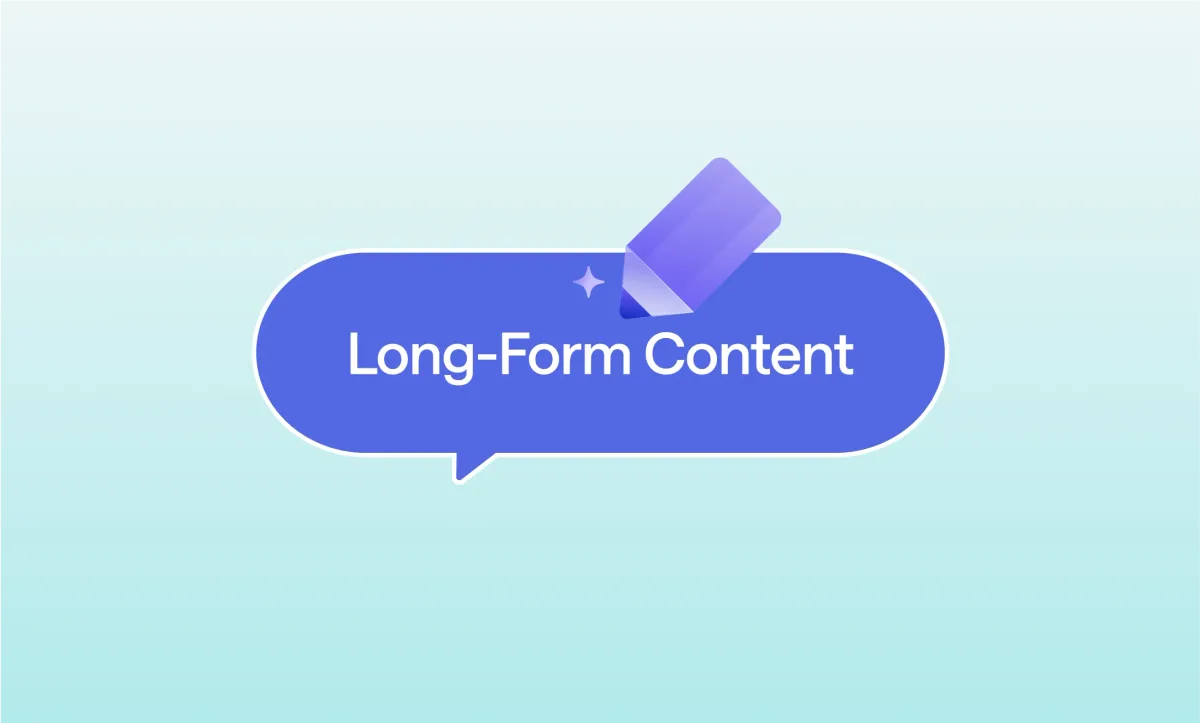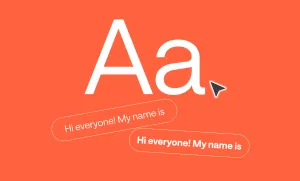Most of what you see online disappears in seconds. But every now and then, something pulls us in: a video we finish, a podcast we listen to on the way home, and a story that lingers. That’s the power of long-form content, and in 2025, it’s more valuable than ever.
Short-form may dominate the feed, but content creators and brands are currently thriving by building trust, sparking conversations, and sharing ideas worth sticking around for, mainly through long-form content like interviews, podcasts, story-time segments, and more.
If you’re thinking of joining them or just want to make your long-form content better, stick around because we’re going to define what exactly long-form content is, why it works, and how you, too, can succeed with it.
Overview
- Long-form content builds deeper trust, stronger SEO, and better monetization than short-form.
- YouTube, podcasts, and even TikTok are rewarding longer content more than ever right now.
- A strong hook, steady pacing, and clear structure are key to keeping viewers engaged.
- One long-form piece can fuel weeks of repurposed clips, blogs, and social posts.
Listen to this article
What is Long-Form Content?
Long-form content is the opposite of fast-scroll media. It’s the kind of content that invites people to stay, listen, learn, or reflect. In a digital landscape where attention spans are often measured in seconds, long-form stands out by offering substance and value. The one key goal for all types of long content is to build organic engagement.
In 2025, long-form content spans across platforms and formats. Here's what it commonly looks like today:
- YouTube videos: These range from 15-minute explainer videos to 60-minute documentaries or thought pieces. YouTube itself reports that videos over 10 minutes tend to perform better in terms of both engagement and monetization.
- Podcasts: Popular episodes now frequently exceed 45 minutes. According to recent research, 62% of weekly podcast listeners in the U.S. finish entire episodes, showing a clear appetite for long-form audio.
- Webinars and live streams: Brands and content creators host 45-90 minute sessions packed with tutorials, discussions, or live Q&As. The average viewing time for webinars in 2024 was around 51 minutes.
- Documentaries and mini-series: Whether on YouTube or streaming platforms, documentary storytelling has gained traction, particularly for niche and educational content.
- Blog posts and articles: In written form, long-form typically starts at 1,500 words. Articles between 2,100 and 2,400 words tend to perform best in search engines. Additionally, Backlinko reported that long-form content gets 77% more backlinks than shorter articles.
Why Long-Form Content Still Works
Long-form content offers a rare opportunity: to connect time and space meaningfully. While short-form content will always have a place in digital strategy, long-form is where deeper relationships, better SEO, and lasting value are built. For creators, brands, and educators alike, it remains one of the most powerful tools in the content toolkit, and here’s why:
1. Deeper Engagement and Trust
Longer content fosters more meaningful interaction. According to a study by Medium, readers engage for about seven minutes with long-form posts, substantially more than the average page view time on short content. Longer formats allow creators to educate, entertain, and connect with their audience on a personal level. This leads to greater trust and loyalty.
2. SEO and Discoverability
From an SEO perspective, longer content consistently outperforms shorter pieces. A 2024 study by Semrush showed that articles over 3,000 words receive three times more traffic and 138% more shares than articles under 1,000 words. Google’s evolving algorithm increasingly favors in-depth, helpful content, making long-form crucial for visibility.
3. Monetization Benefits
Platforms like YouTube favor longer videos not only for ad placement, but also for watch time, one of the key signals in their algorithm. Creators who produce 10-30 minute videos often see higher earnings per video and better recommendations.
Additionally, creators posting long courses, memberships, or sponsorships tend to have more monetization options, proving that consumers prefer brands to tell stories through lengthier, more informative content formats.
4. Repurposing Opportunities
A single long-form piece can be turned into multiple smaller assets. For example, a 30-minute video can generate short clips, blog posts, infographics, quotes, and more. Moreover, 41% of marketers say they get the best results when long-form content is repurposed across channels.
Best Platforms for Long-Form Content in 2025
Not all platforms are equal when it comes to long-form content. Some reward educational deep dives, others boost storytelling, and a few prefer community-driven conversation. In 2025, the key is knowing which platform suits your message and how to shape your content to thrive there.
Here’s a breakdown of the best platforms for long-form content right now, and what works on each one:
1. YouTube
Best for: Video essays, tutorials, storytelling, reviews, vlogs
Ideal length: 10-45 minutes
Tone: Authentic, conversational, or polished (depending on niche)
Why it works: YouTube is still the king of long-form video. The platform favors watch time over views, meaning the longer your content can hold attention, the better it performs in recommendations. YouTube videos over 10 minutes also allow for mid-roll ads, giving creators more monetization opportunities. Channels that create series, in-depth explainers, or personal narratives tend to grow loyal audiences fast.
2. Podcast Platforms (Spotify, Apple, Amazon)
Best for: Audio series, interviews, niche discussions
Ideal length: 30-60 (and even more) minutes
Tone: Relaxed, informative, personal
Why it works: Podcasts are intimate. Whether someone’s commuting, cleaning, or working out, they’re giving you their ears, and often their full attention. In 2025, podcast discovery has improved, with platforms investing in better recommendations and niche curation. Long-form podcasts can easily be repurposed into reels, newsletters, or blog summaries.
3. Instagram (Yes, really!)
Best for: Video carousels, long captions, educational reels
Ideal length: Reels: 60-90 seconds; Captions: 200+ words
Tone: Personal, warm, story-driven
Why it works: While Instagram is built for visual and short-form media, creators are carving out space for depth. Many are using long captions to share microblog-style reflections, while carousel posts and reels are being used to break down complex topics visually. Think “7 things I wish I knew before starting a business” in slides or “Day in the life” long Instagram videos with voiceover storytelling.
4. LinkedIn
Best for: Professional insights, industry commentary, case studies
Ideal length: 800-1500+ words for articles; 2-5 minutes for videos
Tone: Conversational but credible
Why it works: LinkedIn has grown far beyond resume talk. In 2025, it's a hub for thought leadership. Creators and professionals use it to share detailed posts, long-form articles, and video essays around work, innovation, and growth. Its organic reach is still strong, especially for content that feels genuine and useful, not overly polished or salesy.
5. Medium
Best for: Opinion pieces, storytelling, deep-dive articles
Ideal length: 1500-3000 words
Tone: Reflective, educational, narrative
Why it works: Medium rewards quality and consistency. Its built-in audience often seeks out long-form reads, whether personal essays, guides, or cultural commentary. Writers benefit from a partner program that pays based on reader engagement time, not just views.
6. TikTok
Best for: Storytelling series, educational content, behind-the-scenes, mini-vlogs
Ideal length: 1-3 minutes (but up to 10 minutes is now common)
Tone: Casual, quick-paced, relatable
Why it works: TikTok may have built its name on short-form trends, but it’s quickly evolved. In 2025, long-form videos on TikTok are not just possible, they’re thriving. Creators are using the 3-10 minute range to tell full stories, teach concepts, or create serialized content that spans multiple posts. Creators in niches like personal finance, true crime, history, wellness, storytelling, and career advice are especially succeeding with longer TikToks. And since many users now treat TikTok like a search engine, quality long-form videos tend to have a long shelf life.
How to Create and Grow with Long-Form Content
Diving into long-form content can feel intimidating at first, especially when you’re used to creating quick hits for fast-scrolling feeds. But once you get the hang of it, it becomes one of the most rewarding formats to build trust, tell your story, and grow a loyal audience.
So, how to get started and how to grow without burning out:
1. Plan Before You Press Record (or Write)
Great long-form content starts with structure. That doesn’t mean you need a full movie script, but a roadmap helps. You can start with:
- A strong hook: What will make someone stop and listen within the first 10 seconds? Ask a question, promise a payoff, shock your audience, or tease something unexpected.
- A clear outline: Break your content into sections (intro, core points, takeaway). This helps you stay focused and helps your audience follow along.
- One core idea: Don’t try to cover everything at once. Long-form doesn’t mean rambling; it means going deeper into something specific.
Unless you're producing a documentary, full scripting isn’t always necessary. Instead, try these:
- Bullet-point scripting: Write out key phrases, transitions, and data points so you sound natural while staying on track.
- Use voice-to-text tools if you think better out loud, transcribe, clean it up, and build from there.
Long-form thrives when it feels real. You don’t have to sound like a news anchor, just like yourself.
2. Keep the Pace Moving
Even if your video is 30 minutes, don’t let it drag. You can change visuals or camera angles every 15-30 seconds (especially on YouTube and TikTok) or use jump cuts to remove dead space or hesitations. You can also add background music that subtly enhances the mood without overpowering your voice. Study how successful creators pace their content. Long doesn’t have to mean slow.
3. Use Chapters and Visual Cues
Chapters aren’t just for books. On YouTube and podcasts, they’re essential for keeping people engaged. Use timestamps so people can jump to the parts they care about. Overlay text or graphics to signal when you’re shifting topics; this helps with attention and comprehension. And use AI tools (like Podcastle) to auto-generate sections, subtitles, or visuals. The more guided your viewer feels, the more likely they are to stick around.
4. Thumbnails, Titles, and First Impressions Matter
Long-form content needs a strong reason to be clicked on. Design clear, clean thumbnails with bold text and high-contrast visuals. Write titles that promise something specific, not vague. “How I Paid Off $20K in Debt in One Year” beats “My Money Story.” For podcasts, the title and show notes matter just as much, giving people a reason to hit play.
5. Build a Long-Form Ecosystem
Growing with long-form means thinking beyond one piece of content. Repurpose, republish, and repackage. You can turn a podcast into quote graphics, blog posts, or Shorts. Break a 30-minute video into 3-5 clips for Instagram Reels, TikTok, or YouTube Shorts. Don’t forget to use playlists to group related videos or episodes together; this boosts binge-watching and session time.
Many creators grow faster from the short clips that came from their long-form content than from the original video itself.
6. Consistency Over Perfection
No one gets long-form perfect on the first try. You’ll learn as you go. Start with what you have, like your phone, your mic, your ideas, and build from there. Consistency beats perfection every time.
The truth is, most people aren’t craving “perfect.” They’re craving real. They want insight, honesty, or a deeper look behind the scenes. That’s where long-form wins, and where you get to build something that lasts.
How to Create Long-Form Content with Podcastle
Long-form content needs the right tools to keep it sounding smooth, looking clean, and feeling professional.
An hour-long podcast episode, a deep-dive YouTube video, a lengthy Instagram or TikTok content, or a full audio documentary, all effortlessly get that polished and impeccable quality when made with Podcastle.
Podcastle is built to help creators, marketers, and professionals go from idea to publish-ready content in one browser-based platform. No need for multiple apps or steep learning curves. Just open your tab and get creative.
Here’s how you can easily record, edit, and polish long-form content using Podcastle:
1. Record Your Audio or Video
Start by logging into Podcastle and clicking "Create." You can choose between audio or video recording, and select solo mode or invite remote guests to join. Podcastle's remote video interview feature records each participant on a separate track and in high quality, so you're always in control during the editing phase.
2. Edit Using the Transcript or Timeline
After the recording is complete, your audio or video will be automatically added to the editing timeline.
When it comes to audio recordings and files, you can edit them by either modifying the transcript (just delete words or phrases to cut them from the final file) or manually cutting and rearranging your segments.
In the video editor, you can cut or split your video, resize it according to the platform you want to post it on, add subtitles, music, stock videos, audio effects, and even generate a completely new voiceover using the 1000+ realistic AI voices the platform offers.
3. Enhance Audio and Video with AI Tools
For both audio and video editing, Podcastle offers a large variety of AI tools to help you further improve your long-form content. You can clean up background noise, improve voice clarity, and enhance overall production with a single click. For video content, tools like background blur, eye contact correction, video quality enhancer, and AI subtitle generator help you create professional-looking visuals, no extra software required.
4. Export, Repurpose, and Publish
Once your content is ready, Podcastle allows you to export it in multiple formats. Download your transcript for SEO purposes or repurpose the content into blog posts and captions. You can also resize your video to suit various platforms or export just the audio for podcast distribution.
Summing Up
In a world of scrolls, swipes, and 15-second clips, long-form content is your chance to slow things down and say something that sticks. Whether it’s a deep-dive video, an honest podcast conversation, or a thoughtful article, long-form is where the real magic happens. It’s how you build trust, share your voice, and create something people want to come back to.
You don’t need a full production team or a stack of expensive gear to make it happen. With Podcastle, long-form content becomes simple. You can record a remote interview, clean up your audio, enhance your video, and publish, all in one place, right from your browser.
So if you’ve been waiting for the right time (or the right tool) to finally go long, this is it.
Start with one episode. One video. One story. Podcastle will help you take it from there.








